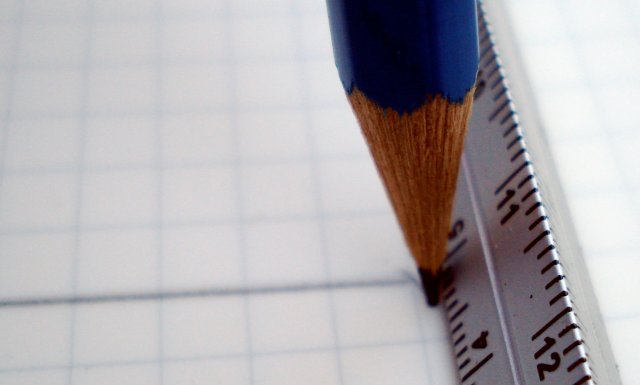
Let’s take a brief trip into the almost departed world of drafting by pencil. Before computer aided design (CAD), precision drawings were made by hand. Architects, draftspeople, engineers, and others, used lead pencils alongside other tools to create plans for everything from small industrial parts to immense cities.
The observations made here are probably trivialities to those familiar with the tools. Yet as an “obsolete” technology, the capabilities of drafting film and film pencils may be unknown to those of us who never experienced these products first hand, and I thought it would be enjoyable to share some discoveries.
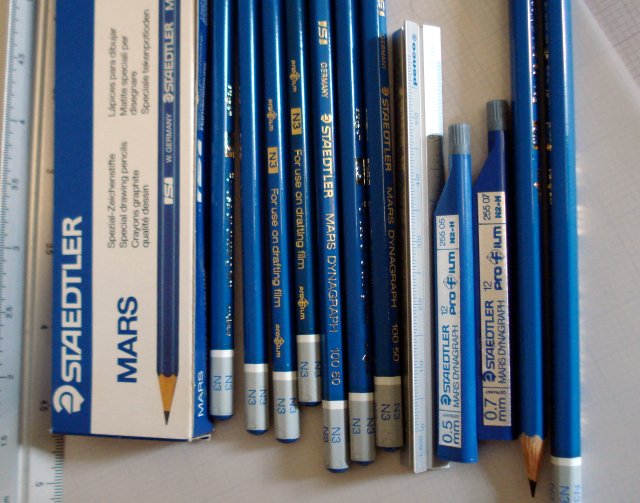
I’ve been fortunate to be able to assemble some vintage supplies.
– Staedtler Mars Dynagraph 100 50 woodcase pencils in grade N3.
– Staedtler Mars Dynagraph 0.5mm (255 05) and 0.7mm (255 07) mechanical pencil leads in grade N2.
– Mylar polyester drafting film.
The lead refills and drafting film were purchased at retail about two weeks ago! The pencils came from eBay.
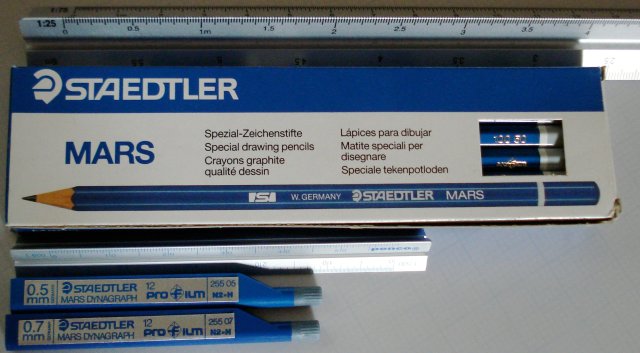

Some further notes.
The grades – N0 through N6. An old Staedtler catalogue online at leadholder.com suggests these comparisons:
N0 = HB
N2 = H
N4 = 5H
Adding information from this fascinating chart at Lowell Bueprint, we can complete the chart this way:
N0 = HB
N1 = F
N2 = H
N3 = 3H
N4 = 5H
N5 = 7H
Both the pencils and the leads have an additional logo, “profilm”. Though I own many Staedtler pencils, I have not seen this additional graphic before. This site, for example, suggests that this is an early 1980s Staedtler trademark, now abandoned.
The pencils are explicitly marked “For use on drafting film.”
The film is something I’ve been seeking for some while. I was quite happy to discover a local retailer who was willing to cut a small piece for me off of a roll. Mylar is Dupont’s trademarked name for polyester film. There are other brands, but Mylar seems to be a bit of a standard.
The photos below generally show the Mylar on top of graph paper – either 2mm vellum, or a Moleskine notebook. This is for contrast – it had to be placed on some sort of surface. The Mylar does not have any lines. It does have a milky translucence, and feels quite strong to the touch.

Observation no. 1: The erasure of Dynagraph pencil lines on Mylar is remarkable. To my own eye in direct sunlight, it seemed close to perfection. The macro setting of the camera brings one back to earth, but still, I have to say that the erasure properties of the N3 Dynagraph pencil/Mylar film/Mars plastic eraser trio well surpass the paper and pencil experience. Even the typical paper indentation that one can usually discern is absent, presumably due to the film’s strength.
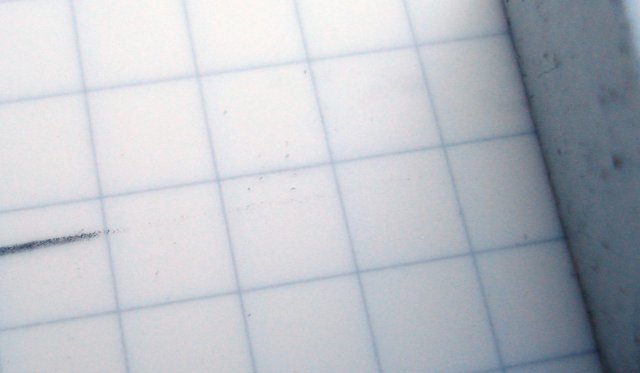
Observation no. 2: The specialty lead is truly non-smearing! To the right is the misbehaving Staedtler Mars Lumograph 2H. Light finger movement causes considerable smudging. The Dynagraph leaves a nearly immutable line.
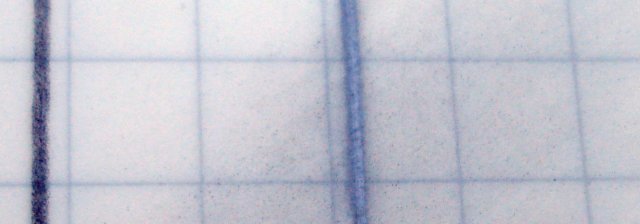
Observation no. 3: Pencil grades, even the very hard grades that behave like rocks on paper, are much more vivid on film. A 3H looks like a 3B. Take the extreme Mitsubishi Hi-Uni 10H:
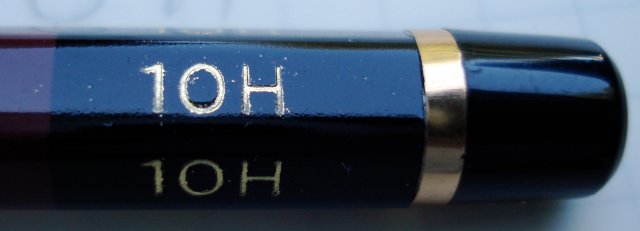
It is near useless, fainter than the printed lines, in a notebook:
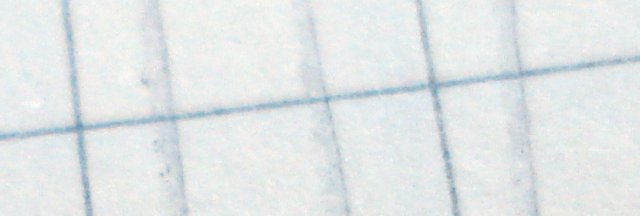
Yet makes a valid mark on the drafting film:
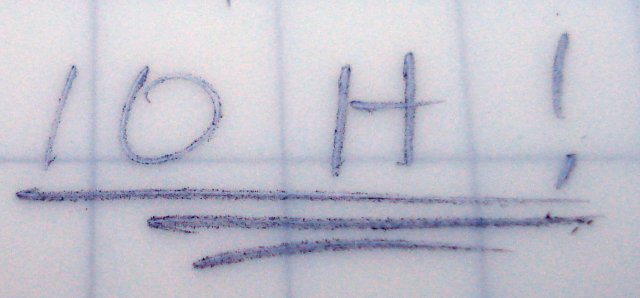
So film certainly gives an invigorated life to those 2H through 10H pencils which are very challenging to use on paper.
To summarize these basic observations about film pencils on film: Perfect erasure, no smearing, and lines appear significantly darker.
The computer isn’t going away, but I’m wondering if these properties might not be valuable to artists. And I haven’t yet noted that this “paper” is supposed to last centuries and maintain stability.
I can’t find a Mylar sketchbook for sale, but did find that David Hockney was aware of this medium. If you use this medium or are aware of other artists who use it, please leave a comment.
And while this post is engaged in a bit of a “rediscovery” of the past, let’s acknowledge those who’ve never forgotten these skills: twenty-first century architects who still work with pencil. These two have mentioned their continued use of pencils at this blog:
Otto-Walker Architects, Park City, Utah
J Mark Nelson LLC, Colorado Springs, Colorado
These products may have peaked in popularity in the 1980s, but the Dynagraph and Mylar duo still seem capable of getting a precision job done.
P.S. Please see “Zeitreise” at Lexikaliker, which shows some vintage advertisements for Duralar (the predecessor name of Dynagraph) pencils on Mylar.

Thank you for that very exciting excursion into the wonderful history of engineering drawing!
This is a great and very informative post. Very good research too. I like how these hard pencils quite useless on paper spring to life on drafting film.
Try using colour pencils or best of all, Derwent pastel pencils on Mylar.
Thank you for the comments.
Just in case anyone hasn’t seen the post update, please also visit “Zeitreise” at Lexikaliker, which shows some vintage advertisements for Duralar (Dyangraph’s predecessor name) pencils on Mylar.
Saumiq, do you personally use pastel and colour pencils on Mylar?
Draftsmen also used Rapidograph and other technical pens – and they still make tips and inks for these pens for use on mylar. As a pen and ink artist I really ought to try them.
Yes I use both Mylar and Staedtler’s vellum for drawing. They are both very receptive to pencil, inks and pastel, even metallic roller-ball pens. You can also “under-colour”, applying colour or ink to the back of a drawing and letting the colour show through. I have seen examples of this technique used by a Japanese manga artist.
Interesting! I wonder if Mylar was also used for animation cells used in cartoons and anime before it was replaced by the computer? The old animation cells seem to be made of a similar material at the very least and they sometimes have sheets with colored pencil sketches placed on top to help with the animation process.
I did a little searching and found that the material used for animation may be acetate sheets. I wonder if Mylar and acetate sheets are somehow related.
Pisces6 – Mylar is a trade name for polyester plastic, and acetate is another type of plastic material. So, both are clear plastics suited for drawing.
One problem is that I believe polyester sheets are sometimes mistakenly called acatate in some situations, and vice-versa. The words Mylar, polyester and acetate have become somewhat (incorrectly) interchangable in drawing circles to simply mean a “clear plastic sheet for drawing”
I really must take exception to the assertions that the 10H is useless on paper. When the margin for error is measured in fractions of a millimeter, nothing less than a needle sharp 10H will do. That is why the Hi-Uni 10H has become one of my favorite pencils. For this artist it is THE go-to tool for the really tough jobs!
Quite an informative review. Going to have to take a closer look at the Staedtler offerings in the brick and mortar stores that I visit from to time to time to check for similar items.
Saumiq, thanks for the tip about pastel pencils – it really does work! I’ve used coloured pencils for “under colouring” on film but I just thought that pastel would fall right off.
Michael Moncur, take care – drafting film is death to Rapidographs and the like. It wears away the tip faster than you’d think possible. Drawing pens for film have sapphire tips.
Elvis882 (http://elvis882.deviantart.com/art/i-don-t-like-to-share-171970280?q=&qo= ) Uses them in her amazing art.
I first found out about the dynagraphs from my dad who was an architect, they’re really good for light shading and i’m glad they can erase haha
Elvis882, thanks for dropping by. I find it really interesting that you are having such success using these as a medium.
I wonder if Staedtler has a stash tucked away in a warehouse?
I am in the hunt for an old Staedtler microFIX 0.5mm pencil.
Does anyone know where i can purchase one?
I still use Mars Dynagraph Pencils for architectural drawing and shading on Mylar. If anyone has a source for N1 N2 or N3 Plastic lead pencils please let me know>
Thank you. Bruce
If anybody is interested I have 2 cartons of N3~3H leads for STAEDTLER® Mars® technico 780 C leadholders. I can contribute a lead holder and a sharpener. Each carton has 12 dispensers. Each dispenser has 12 leads. I also have ~20 N2 wood pencils.
I forgot to add these are marked Pro-Film
I want to purchase some mylar lead for drafting film.
gene sherman 208-522-5258
A friend used to be a draftsman at Avro, in Canada. For their precision work they dispensed with pencils entirely and worked with sticks of aluminum that had been ground to a sharp point in the machine shops.
Great article!
I’m not sure if your lead picture is implying using a scale as a straight edge – I should hope not!!
There’s currently a whole load of these pencils on eBay UK for £2.79 a dozen, including postage. No affiliation to the seller — just a happy customer. (I bought six dozen of the N0/HB grade; I rather like the blackness of the lead, and the smear-resistance on regular paper.)
Great! Thank you for sharing that.
whats the difference between staedtler mars dynagraph and mars lumograph?
Hi there
I’m an artist in need of some info about the Staedtler Mars Dynagraph N1?F leads for lead holders. This one is by far the best type of lead I’ve come across, at least for my purposes.
The qualities of this lead:
When sketching lightly you get light lines that do not confuse the eye and when you press a little harder you get a richer and enhancing, darker line. These lines do not easily smudge which is essential as well. The control you get with this lead is great and I use it with my caran d’ache lead holder.
The problem is that I’m running out of these leads and according to Staedtler ( which I’ve been in contact with ) they no longer produce them. The remaining ones to be found here and there on the internet is a bit pricey mostly. Does anyone know of these leads and where to find a larger amount of them? Or know of other type of leads that possess the same kind of qualities as these leads but which are more easily attainable?
/Michael
I’ve got boxes and boxes of these dynagraph (among other) pencils. If anyone is interested drop me a line.
I recently obtained some Dixon pencils for Drafting Film marked R-1. Does anyone have information about these pencils? I have used Carson Vidalon Vellum to draw on with color pencils and graphite with good results. If drafting film is hard to obtain this vellum works well.
Drafting film, single- or double-sided, was used in archaeology. Field drawings in pencil, weather proof, were subsequently inked on the film with rapidograph ready for publication. Finds were drawn with rapidograph on bristol board, excepting flints, for which crow quills on bristol board were used.
The film was also used for architects’ drawings – its stability and archival properties made it ideal, as well as its’ being weatherproof.
Regarding the difference of acetate VS: Mylar, acetate is thinner and slightly less milky. It was made this way because stacking animation cels on top of each other could result in color shifts if there were too many layers, so the thinner the layers the better. Generally no more than four layers were permissible, unless the color shift was purposefully taken into account and changed accordingly (a very rare procedure). Mylar is thicker and more durable with a slight silver sheen, the durability was intended for more industrial purposes such as drafting, whereas acetate cels in animation were considered waste product throw aways once they were filmed.
I found your site because I could not remember from my days in university, as a design major, the hardness scale if lead. I was specifically searching for the Lumograph N series when I stumbled on your post here. I actually do still have vellum and mylar from my days in school in the mid ’90s, along with most of my supplies as well as my grandfather’s who was a Naval Architect. This was a fascinating article even if it did make me feel old. ?
What an article, and dare I say an even better comments section?
I’m a student studying architecture at the moment, just started drafting some drawings on mylar and am loving it, all my hardest pencils are smudging all over the place, feeling like I’m 20+ years late! Would my best option today would be something more like the 10H pencils as these dynagraph leads are really hard to come by?
Please message if anyone has any advice!
Instagram: zak.samak
Facebook: Zak Samak
Thanks for the article
Zak, I’m glad you like the post. And belated greetings to Nicole as well. Did you know that you are both in the company of Yves Saint Laurent?
As well as woodcase pencils and thin leads, this formula has been used in 2mm leads for clutch pencils and leadholders. That may be another option to consider, as a lot of vintage 2mm lead seems to have survived.
Fortunately, drafting film pencils have not become a collectible, and you can find quite a few at reasonable prices on eBay by searching “dynagraph pencil”, “duralar pencil”, “drafting film pencil”, etc. I see someone is now selling six dozen Ruwe film leads for $10.
It’s also worth looking for Pentel’s ‘P’-graded film leads. I’ve never seen any woodcased Pentel film pencils, but there are lots of tubes of lead in different sizes on eBay UK right now quite cheaply. It’s good quality and seems to perform very similarly to the Staedtler equivalents.
Hello Stephen,
Thank you for this post. I got a lot of refills from staedler MARS Dynagraph Micro and Pro Film N2-H 0.5 mm and didn’t know what i could do with them. Now i know thank you. Don’t know yet if i’m going to use them.
Greetings Josee
From The Netherlands .